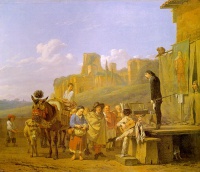Stage (theatre)
From The Art and Popular Culture Encyclopedia

Illustration:Theatrum Orbi engraving by Theodor de Bry from the chapter on Ars Memoriae in Utriusque cosmi maioris scilicet et minoris metaphysica by Robert Fludd.
|
"All the world's a stage, |
|
Related e |
|
Featured: |
In theatre, the stage (sometimes referred to as the deck in stagecraft) is a designated space for the performance of theatrical productions. The stage serves as a space for actors or performers and a focal point for the members of the audience. As an architectural feature, the stage may consist of a platform (often raised) or series of platforms. In some cases, these may be temporary or adjustable but in theaters and other buildings devoted to such productions, the stage is often a permanent feature.
There are four types of stages that vary as to the usage and the relation of the audience to them. The most common form found in the West is the proscenium stage. In this type, the audience is located on one side of the stage with the remaining sides hidden and used by the performers and technicians. Thrust stages may be similar to proscenium stages but with a platform or performance area that extends into the audience space so that the audience is located on three sides. In theatre in the round, the audience is located on all four sides of the stage. The fourth type of stage incorporates created and found stages which may be constructed specifically for a performance or may involve a space that is adapted as a stage.
History
Greeks were the earliest recorded practitioners of stagecraft. "Skene" is Greek, translating roughly into "scene" or "scenery", and refers to a large scenic house, about one story tall, with three doors. On the audience-side of the Skene, what are now known as "flats" could be hung. Flats developed to two-sided painted flats which would be mounted, centered, on a rotating pin, with rope running around each consecutive pin, so the flats could be turned for a scene-change. The double-sided-flat eventually evolved into the periaktoi (pl. periaktos).
As well as flats, the Greeks also used such machines as the ekkyklema, essentially a platform on wheels, and the deus ex machina, a hand-cranked lift to be used to lift a character/scenery over the skene. Over 20 such scenic inventions can be traced back to the Greeks. No light but that of the sun was used; plays started at sun-rise and continued until sun-down.
Plays of Medieval times were held in different places such as the streets of towns and cities, performed by traveling, secular troupes. Some were also held in monasteries, performed by church-controlled groups, often portraying religious scenes. The playing place could represent many different things such as indoors or outdoors (plain-an-gwarry (theatre)). They were played in certain places so the props could be used for the play. Songs and spectacles were often used in plays to enhance participation.
More modern stagecraft was in developed in England between 1576-1642. There were three different types of theaters in London - public, private and court. The size and shape varied but many were suggested to be round theaters. Public playhouses such as the Globe Theatre used rigging housed in a room on the roof to lower and raise in scenery or actors, and utilized the raised stage by developing the practice of using trap-doors in theatrical productions. Most of the theatres had circular-design, with an open area above the pit to allow sunlight to enter and light the stage. It was a penny admission to stand in the pit. Prices increase for seating. Court plays were used for holidays and special occasions.
Proscenium stages, or picture-box stages, were constructed in France around the time of the English Restoration, and maintain the place of the most popular form of stage in use to-date, and originally combined elements of the skene in design, essentially building a skene on-stage. Lighting of the period would have consisted of candles, used as foot-lights, and hanging from chandeliers above the stage.
Lighting continued to develop, first with the help of the English, in an effort to accurately map the coast of England, would triangulate cliff locations by using flame, and two ships at sea. Due to extreme fog, limestone had to be burned in order to see the light from the ocean. English sailors, propagators of many modern stagecraft practices, brought the use of limestone as a light source into the theatre for the purposes of spotlighting, hence the phrase "limelight". To control the focus of the light, a Fresnel lens was used.
Originally intended to replace large, convex lenses in lighthouses, Dr. Fresnel sectioned out the convex lens in a series of circles, like tree-rings, and keeping the angle of the specific section, moved the section much closer to the flat side of the convex lens.
After candles, came gas lighting, utilizing pipes with small openings which were lit before every performance, and could be dimmed by controlling the flow of gas, so long as the flame never went out. With the turn of the 20th century, many theatre companies making the transition from gas to electricity would install the new system right next to the old one, resulting in many explosions and fires due to the electricity igniting the gas lines.
Modern theatrical lighting is electrically-based. Many lamps and lighting instruments are in use today, and the field is rapidly becoming one of the most diverse and complex in the industry.
Robert Edmond Jones’s book The Dramatic Imagination: Reflection and Speculations on the Art of the Theatre masterfully demonstrates some essential ideas of theatre designs.
See also


